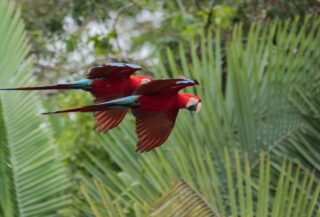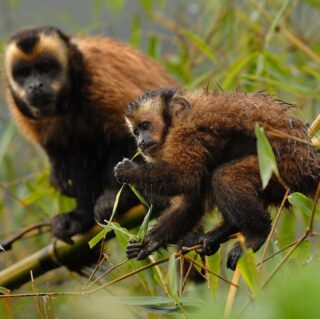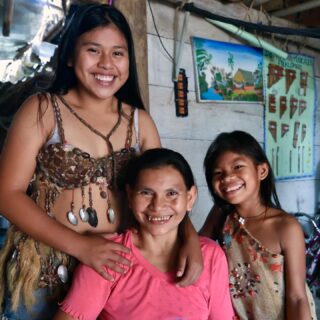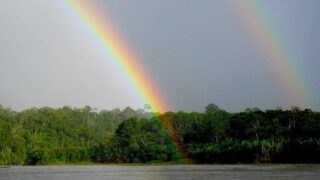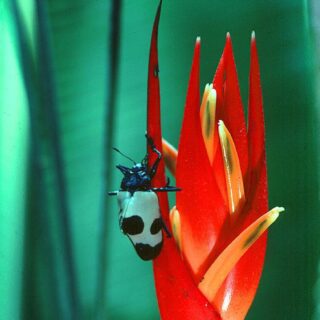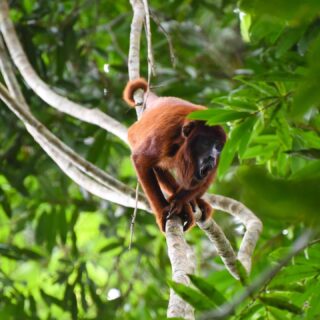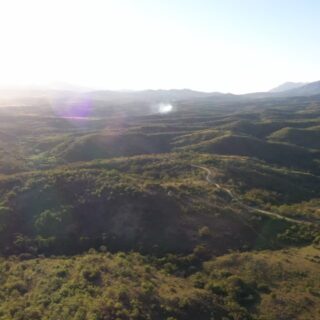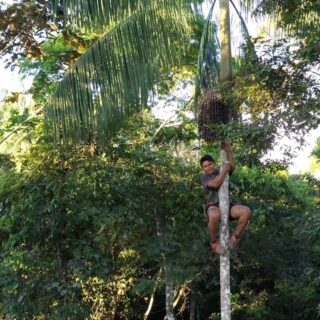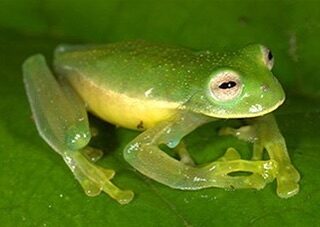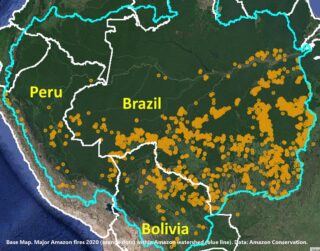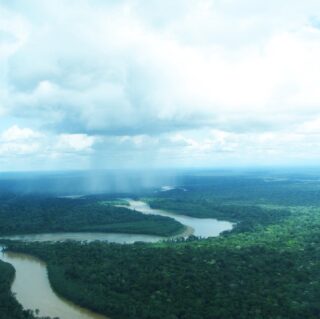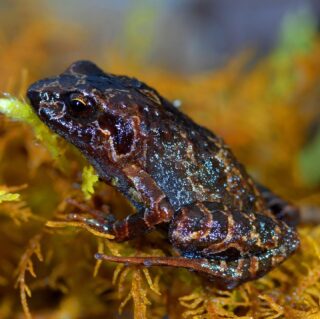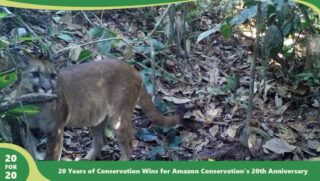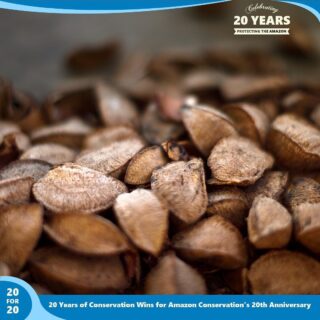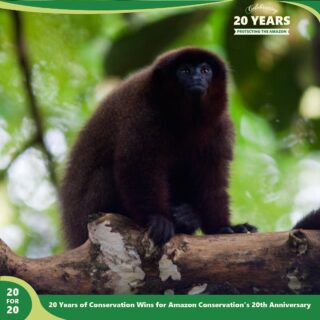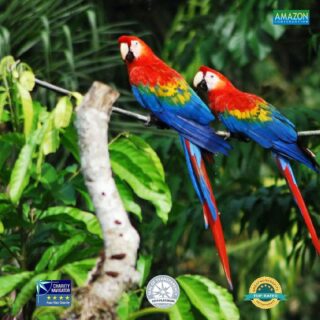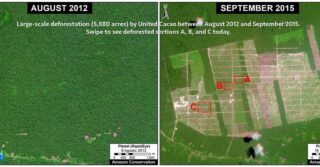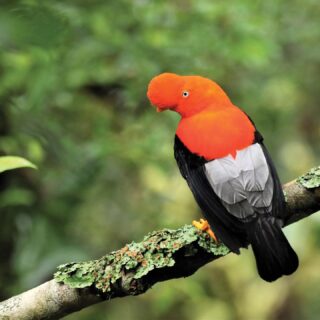 CICRA intern Sarah Federman relates her experience working at the Los Amigos Biological Station.
CICRA intern Sarah Federman relates her experience working at the Los Amigos Biological Station.
Sordid little detail: bugs (although I prefer the Spanish term, bichos – the sound of the word describes more fully my feelings than the hard ending of “bug”) have made off with the rubber parts of my earphones. I am not pleased. However, this is a price I am more than willing to pay to live and work at the Amazon Conservation Association’s Los Amigos Biological Station (known as “CICRA” in Spanish).
I wish I could package the sounds here – trills, screeches, squawks, growls, chirps, clicks, the mechanical hum of cicadas, and the steady patter of the swarm of wasps which flies repeatedly into the metal screens behind me. A flock of birds lives outside the dining hall. When they call, it is like listening to drops of water falling into a metal bowl.
To reach CICRA you must travel up the Madre de Dios river in a motorized canoe for anywhere between five and eight hours. The ride is amazing, opening up a scene of conflicting ideals. The wide river stretches sinuously below an imposing and mysterious wall of shining greens and browns reaching into the glaringly blue sky (or, as the rainy season sets in, the slate grey of an impending downpour); here it is easy to imagine nature as Nature. Below the wall of green, the water is littered with piles of discarded rocks upon which crouch men, women, and children. They sift and add to their ever-growing islands of refuse, which, with time, become archipelagoes of unrealized aspirations. At moments, though, hidden within the chaff is a whisper of gold that glints with the promise of paradise.
 It would be easy to condemn one of these “ideals,” especially when presented with a literal divide at one point during the ride: a conservation concession beyond the bank of the river, with mining on the water. I wonder, though, if there is something more, some entanglement of these two seemingly irreconcilable experiences of the environment. It is this itching question, regarding the contents of the space of friction between two traditionally opposed realities which drives me to study not just ecology, but take a more interdisciplinary route of study.
It would be easy to condemn one of these “ideals,” especially when presented with a literal divide at one point during the ride: a conservation concession beyond the bank of the river, with mining on the water. I wonder, though, if there is something more, some entanglement of these two seemingly irreconcilable experiences of the environment. It is this itching question, regarding the contents of the space of friction between two traditionally opposed realities which drives me to study not just ecology, but take a more interdisciplinary route of study.
 One of the best perks of the job is that I get to organize and teach sábados científicos (Science Saturdays) at the closest town along the river. I was able to coordinate with the town’s teacher to create a year’s worth of lesson plans to complement the students’ scientific curriculum. The children are quite young, so sábado científico classes have a strong emphasis on combining group work, play, and knowledge of local biodiversity and ecosystems with the aim of promoting a sense of communal pride and protectiveness over local flora and fauna. Students often work in teams to solve questions, find and identify useful plants, or act out parts of an ecosystem; in this way we create a positive association between learning, play, and the amazing natural world in which we live.
One of the best perks of the job is that I get to organize and teach sábados científicos (Science Saturdays) at the closest town along the river. I was able to coordinate with the town’s teacher to create a year’s worth of lesson plans to complement the students’ scientific curriculum. The children are quite young, so sábado científico classes have a strong emphasis on combining group work, play, and knowledge of local biodiversity and ecosystems with the aim of promoting a sense of communal pride and protectiveness over local flora and fauna. Students often work in teams to solve questions, find and identify useful plants, or act out parts of an ecosystem; in this way we create a positive association between learning, play, and the amazing natural world in which we live.
ACA provides me with the perfect outlet for continuing and improving my passion for ecological investigations. I am allowed time to work with visiting researchers, allowing me to gain valuable field experience and skills, and to design and implement my own research projects. Thus far, I have designed two which I find quite interesting. The first is to monitor butterfly diversity with standard baited traps on an altitudinal gradient between ACA’s cloud forest station (Wayqecha) and CICRA, focusing on fruit feeding Nymphalidae butterflies as indicators of overall butterfly diversity. This investigation is primarily a “teaching study” maintained by students and volunteers with the intent to create opportunities to gain experience and learn field skills in the tropics. The second project is more of an independent investigation which compares vegetative regeneration in pristine and human-altered sites.
Thus far my work at CICRA has greatly expanded my array of field skills. I am confident that these important skills will further my goal to implement meaningful change as a professor or within a conservation organization, researching and educating on the subjects of ecology and conservation.
(Photos by Rick Stanley and Gabby Salazar)

 Back in February 2010, the government of Peru issued an emergency decree to impose stricter environmental regulations on gold mining. The decree put a hold on approval of new mining claims in Madre de Dios, added controls over where mining is permitted, and prohibited river dredging. The Mining Federation of Madre de Dios (FEDEMIN), afraid the new regulations would cause informal miners to lose their livelihood, called for a strike beginning on April 4. Before the resolution of the four-day strike, violence broke out at a roadblock in northern Peru, resulting in six deaths. (Photo by Walter Wust)
Back in February 2010, the government of Peru issued an emergency decree to impose stricter environmental regulations on gold mining. The decree put a hold on approval of new mining claims in Madre de Dios, added controls over where mining is permitted, and prohibited river dredging. The Mining Federation of Madre de Dios (FEDEMIN), afraid the new regulations would cause informal miners to lose their livelihood, called for a strike beginning on April 4. Before the resolution of the four-day strike, violence broke out at a roadblock in northern Peru, resulting in six deaths. (Photo by Walter Wust) Through this process, large amounts of mercury run into the rivers – polluting fish which are a major protein source in the Amazon – and are absorbed by the soil. Once extracted, the amalgam is burned, releasing the mercury into the air and leaving behind pure gold and a high level of air pollution. In addition to mercury pollution, mining damages riverbanks, contributes to deforestation and, in the case of dredging, destroys riverbeds and silts in the waterways. Some illegal mining operations are carried out within protected-area buffer zones and concessions dedicated to ecotourism.
Through this process, large amounts of mercury run into the rivers – polluting fish which are a major protein source in the Amazon – and are absorbed by the soil. Once extracted, the amalgam is burned, releasing the mercury into the air and leaving behind pure gold and a high level of air pollution. In addition to mercury pollution, mining damages riverbanks, contributes to deforestation and, in the case of dredging, destroys riverbeds and silts in the waterways. Some illegal mining operations are carried out within protected-area buffer zones and concessions dedicated to ecotourism. ACA’s hosting of NPR journalists in the summer of 2009 resulted in an award-winning multimedia package.
ACA’s hosting of NPR journalists in the summer of 2009 resulted in an award-winning multimedia package. The group witnessed miles of deforestation, but they also visited one of the few glimpses of hope in the Amazon basin – ACA’s
The group witnessed miles of deforestation, but they also visited one of the few glimpses of hope in the Amazon basin – ACA’s  November–January, Wayqecha is a magnificent wonder of flowering plants, curious animals, and diverse birds seldom seen at other times of year. Story by Wayqecha intern Laura Morales.
November–January, Wayqecha is a magnificent wonder of flowering plants, curious animals, and diverse birds seldom seen at other times of year. Story by Wayqecha intern Laura Morales.
 full of bristles as to strike fear into the heart of the most experienced biologist lest he put his hand on one accidentally. And of course the myriad orchids in Wayqecha begin to bloom more abundantly at this time of year.
full of bristles as to strike fear into the heart of the most experienced biologist lest he put his hand on one accidentally. And of course the myriad orchids in Wayqecha begin to bloom more abundantly at this time of year. During field trips earlier this year to the community of Toromonas, in northwestern Bolivia, ACA-Bolivia team members came across four species that had never previously been registered in that location. These species include the lesser sac-winged bat (Saccopteryx leptura), and several birds: the black manakin (Xenopipo atronitens), Snethlage’s tody-tyrant (Hemitriccus minor), the brownish twistwing (Cnipodectes subbrunneus), Thamnophilus stictocephala, and Heterocercus linteatu.
During field trips earlier this year to the community of Toromonas, in northwestern Bolivia, ACA-Bolivia team members came across four species that had never previously been registered in that location. These species include the lesser sac-winged bat (Saccopteryx leptura), and several birds: the black manakin (Xenopipo atronitens), Snethlage’s tody-tyrant (Hemitriccus minor), the brownish twistwing (Cnipodectes subbrunneus), Thamnophilus stictocephala, and Heterocercus linteatu. and clearly understudied Pampas del Heath savannas just north of Madidi National Park. ACA staff have created monitoring protocols for hunting and fishing in order to develop management plans for local biodiversity conservation in these communities. By learning how to measure the impact of their own hunting and fishing activities and role of local wildlife, the community members are establishing sustainable hunting and fishing practices for the future. (Photos by Omar Martinez)
and clearly understudied Pampas del Heath savannas just north of Madidi National Park. ACA staff have created monitoring protocols for hunting and fishing in order to develop management plans for local biodiversity conservation in these communities. By learning how to measure the impact of their own hunting and fishing activities and role of local wildlife, the community members are establishing sustainable hunting and fishing practices for the future. (Photos by Omar Martinez) ACA’s Peruvian sister organization, the Asociación para la Conservación de la Cuenca Amazónica (ACCA), recently purchased 7,576 acres of land in southern Peru, thanks to funding from ACA, the
ACA’s Peruvian sister organization, the Asociación para la Conservación de la Cuenca Amazónica (ACCA), recently purchased 7,576 acres of land in southern Peru, thanks to funding from ACA, the  Bats are among the least understood and most loathed mammals on the planet. Myth and legend paint them as cruel vampires that would not hesitate to drink all the blood from their innocent victims. While it is true that three blood-sucking species exist in the world, they are not as cruel as myths make them seem, and there are many other species that have important roles in their ecosystems. In rainforests in particular, bats control insect populations, serve as pollinators and seed dispersers for numerous plant species, and in some cases regulate populations of small vertebrates, providing balance to the intricate web of life in the forest.
Bats are among the least understood and most loathed mammals on the planet. Myth and legend paint them as cruel vampires that would not hesitate to drink all the blood from their innocent victims. While it is true that three blood-sucking species exist in the world, they are not as cruel as myths make them seem, and there are many other species that have important roles in their ecosystems. In rainforests in particular, bats control insect populations, serve as pollinators and seed dispersers for numerous plant species, and in some cases regulate populations of small vertebrates, providing balance to the intricate web of life in the forest. REDD—
REDD— degraded lands with green firebreaks that are enriched with profitable Andean plant species. Already, ACA has developed fire prevention workshops in partnership with Manu National Park and begun hosting them in local communities.
degraded lands with green firebreaks that are enriched with profitable Andean plant species. Already, ACA has developed fire prevention workshops in partnership with Manu National Park and begun hosting them in local communities. forest degradation, and greenhouse gas emissions in the Andes. These studies will provide communities with information they need to make good decisions about resource management.
forest degradation, and greenhouse gas emissions in the Andes. These studies will provide communities with information they need to make good decisions about resource management. ACA’s research station functioned as a world-class photo studio for Graham D. Anderson, a leading wildlife photographer, who served as
ACA’s research station functioned as a world-class photo studio for Graham D. Anderson, a leading wildlife photographer, who served as  “My experience at Los Amigos was fabulous. I am looking forward to my travels to
“My experience at Los Amigos was fabulous. I am looking forward to my travels to  The Peruvian Minister of Environment, Dr. Antonio Brack Egg, attended the 8th annual
The Peruvian Minister of Environment, Dr. Antonio Brack Egg, attended the 8th annual